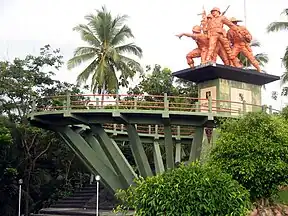| Operation Trisula | |||||||
|---|---|---|---|---|---|---|---|
 Trisula Monumen in 2010 | |||||||
| |||||||
| Belligerents | |||||||
|
| |||||||
| Commanders and leaders | |||||||
|
|
| ||||||
| Strength | |||||||
|
5,000 Troops Air Support : 2 A-26 3 P-51 1 C-130 3 T-6 4 Mil Mi-4 | unknown | ||||||
| Casualties and losses | |||||||
| 18 Killed |
33 Killed 850 Captured | ||||||
Operation Trisula was an operation carried out by the Indonesian National Army in order to crush the remnants of the Communist Party of Indonesia who fled in the South Blitar area. The South Blitar area is very strategic as a hiding place for Communist Party of Indonesia leadership following the 1965-1966 crackdown against the party, because the area consists of steep cliffs and hills that are difficult for ground troops to reach. To carry out this operation, the Commander of the VIII/Brawijaya Military Regional Command formed an Operations Task Force Command called the Trisula Task Force on May 25, 1968, with the operational areas of South Blitar, South Malang and Tulungagung.[1]
Implementation of Operation
In essence, the Trisula Operation area covers the entire East Java region, namely the area of Kodam VIII/Brawijaya, but the plan has changed and is only focused on South Blitar. Through intelligence operations carried out long before Operation Trident, it was discovered that South Blitar was a center for the recovery of the PKI. The PKI had made South Blitar a base area for PKI rebuilding throughout Indonesia. The implementation of Operation Trident was preceded by a shift in troops to designated sectors, the entire operational area was closed starting June 5, 1968. The closure boundaries started in three directions:
West: Campur Darat, South Tulungagung.
North: along the Tulungagung highway along the Brantas River to Kalipare, South Blitar.
East: Kalipare straight south via Sumbermanjing Kulon to the Indian Ocean coastline.
Assistance personnel in closing the operational area involving Hansip, Wanra and the people carrying out village patrols. The purpose of closing it is so that the remaining PKI leadership do not escape from the regional base. Apart from that, it was also hoped that the closure would isolate the Southern region and prevent external assistance from being provided to the PKI in South Blitar. This closure line also functions as a Straggler Line for operational units. The operational area is closed day and night and only a few access corridors have been created, but they remain under strict supervision by officers.
On May 26, 1968, Mayor Inf Soekotjo as Commander of Yonif 531/Para and Mayor Inf Djasripan as Section I Officer of Brigif Linud 18/Trisula conducted an investigation and investigation to obtain the latest information from the operational area. The results of the search were submitted to the Commander of the Trisula Task Force on May 28, 1968, for discussion and as guidance in taking operational action in the field.
With the formation of the SATGAS composition and operational plan, all components for carrying out Operation Trisula have been completed. Kodam VIII/Brawijaya as the executor has full authority to coordinate all regular infantry units in carrying out the main operational tasks. Therefore, in preparation for eradicating the remnants of the PKI in South Blitar, the battalions formed as SATGAS Trisula were battalions under the structural line of Kodam VIII/Brawijaya East Java. Other combat support elements included in the implementing battalion came from the Kostrad and Intel Corps units.[2]
References
- ↑ Media, Kompas Cyber (2022-01-05). "Operasi Trisula, Penumpasan Sisa-sisa PKI di Blitar Selatan". KOMPAS.com (in Indonesian). Retrieved 2023-10-01.
- ↑ Riady, Erliana. "Mengingat Penumpasan PKI di Blitar Selatan Lewat Monumen Trisula". detikjatim (in Indonesian). Retrieved 2023-10-01.